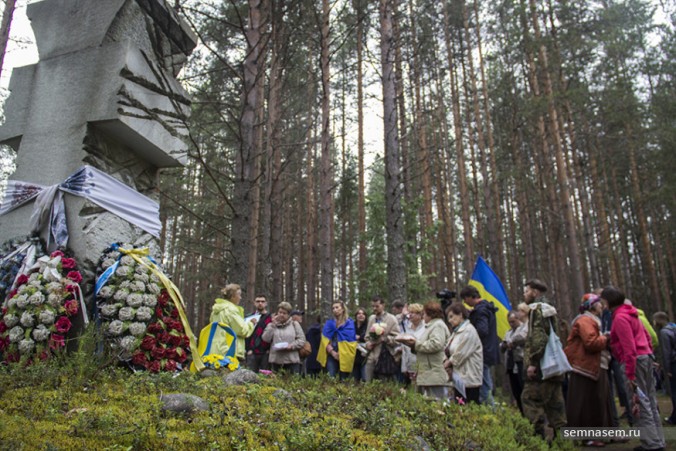Yury Dmitriev in his own words
“Sandarmokh means something special to me. It’s where I’ve put into practice several other tasks I set myself.
“I’d like the people living in Karelia to feel that they are part of a nation, and not just the population. Belonging to a nation means you know your own history, language, culture and traditions. The population is anything that shows signs of life. To govern a nation, you must know and respect its customs, traditions and codes of behaviour; the population can be managed anyway you like. A nation can’t be herded about, it will stand its ground. The population is easy and simple to direct. To stand firm and survive this uncertain period, so that those in charge are replaceable, they are elected, we need to educate our nation.

Ukrainian monument at Sandarmokh, 5 August 2017
“I have been using Sandarmokh as a testing ground. I approach some diaspora within the republic and give them lists of their comrades. I explain that they belong to the same nation. If your people fell victim to such misfortune and were killed, there is no one else but you to look after them. Why? Because you’re part of that nation and so are they. It’s just that some are dead, and others are living. Well, I don’t rush things … And you know what? — people begin to think of themselves as a nation. And the more nations there are, the less easily we can be pushed around!
“When the Poles put up their monument at Sandarmokh they created their own Polish society in Karelia and ever since it’s been at work, teaching people about their culture, and thank God for that. They understood that apart from living here and being citizens of Russia, they are also members of a nation, with their own tradition and culture. To love it, you must at the very least know it. That’s excellent. It’s wonderful when you can hear German, Jewish, Finnish and Polish songs at a concert somewhere. Folklore is always marvellous: songs are the soul of a nation. At Sandarmokh it’s all very convenient. You can bring people there and show them: ‘What about you? Are you worse than the others? This lot have put up a monument, so have that lot. Are you poorer than everyone else?’
“They collect money and it brings them together. After that they may split up, but it’s unlikely: they’ve been united by a cause. If they’d been drinking together then they might forget, once the hangover passed. But they came together for a reason and, do you know, there’s never been any hostility there: no one has ever said a bad word about anyone else. People stand in front of one memorial and pay homage, then they go to another memorial and pay their respects. We share a common grief, and it brought us all to the same place.
“I’m now preparing a CD with lists of native Karelians who were shot. I’ve gathered their names from all over Russia, anywhere I could find them. Then I organised the entries by place of birth, and place of residence. The main entry is by place of birth. Since I was thinking of moving away, somewhere else, this was my parting gift to the Karelian people. For their warmth and kindness, as thanks for having lived among them, and learned from them. It’s a way of showing my respect. There aren’t so many native Karelians today. They’re in decline because the State provides almost no funding to support ethnic culture. They’ve just closed the last Finnish-language magazine.
“So, there you have it. Consider me a nationalist in the widest sense of the word.”
Excerpt from “My Path to Golgotha“,
an interview with Irina Galkova (Memorial)
Pingback: Thousands of victims of the Stalin regime – Worldviewer
Pingback: Dead or living, they’re the same nation – VIRTUAL BORSCHT